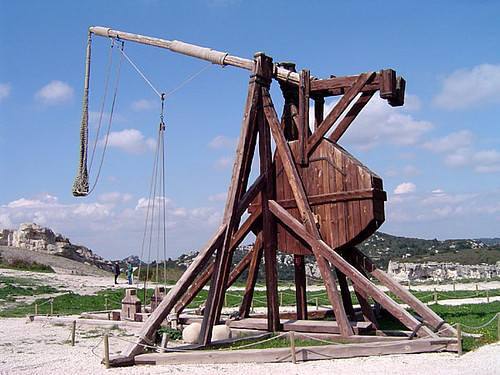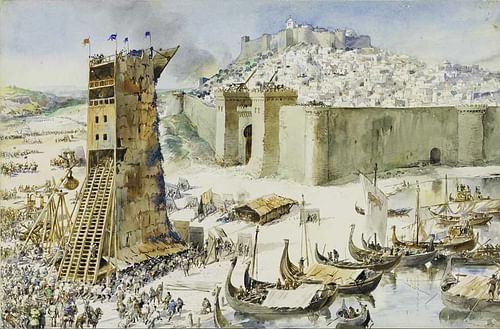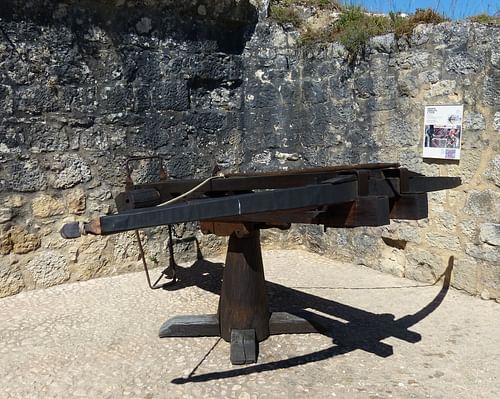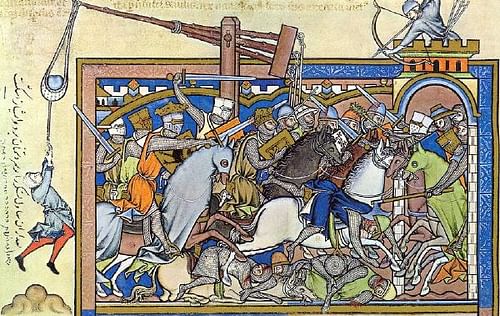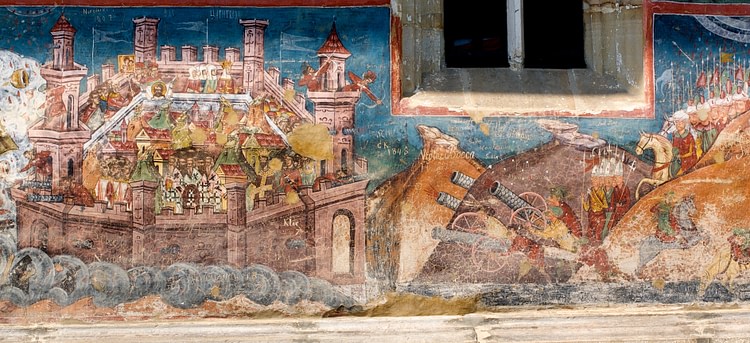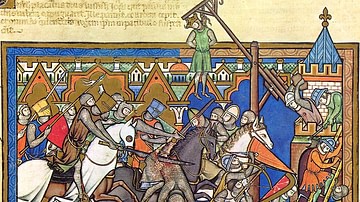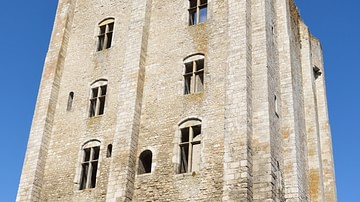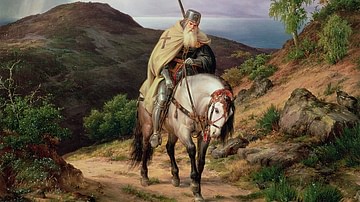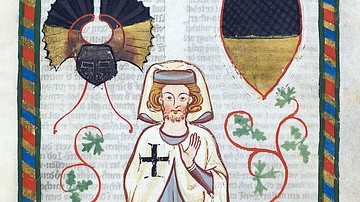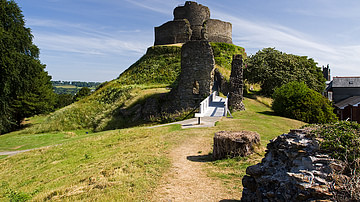Artillery weapons in medieval Europe included the mounted crossbow (ballista) and single-arm torsion catapult (mangonel), both similar to ancient Roman machines. As armies battled further afield such as in the Byzantine Empire and against the Arab caliphates, in particular, so new ideas spread from China and India across Eurasia and into western Europe. The trebuchet arrived from the late 12th century CE, which was similar to the mangonel but used a counterweight as a means to propel missiles further and with greater accuracy. Used by both attackers and defenders during siege warfare, batteries of artillery caused devastation to people and fortifications. Cannons were used from the 13th century CE, and although they were highly dangerous to use and largely ineffective because of their lack of accuracy, by the 15th century CE, technology had improved dramatically. Gunpowder-projected missiles of all sizes became the norm, finally ending the knight's and bowmen's long domination of the medieval battlefield.
Origins & Development
Artillery machines were used to good effect throughout antiquity with the Romans reaching the peak of perfection and employing sophisticated and efficient missile launchers of great variety. Then the fall of the Roman Empire in the west and the fragmentation of Europe into smaller kingdoms meant that few rulers either needed or could afford to maintain specific artillery units in their armies from the 5th to 11th century CE. For this reason, artillery know-how in Europe was largely only perpetuated through books in the early medieval period, but it was never lost completely.
As international warfare spread from the second half of the 11th century CE and castle-building really took off, starting with the Normans in France and Britain, so siege warfare became the most common form of conflict. It was here that artillery weapons were most needed, especially as defensive fortification design became more sophisticated and stone was now the common construction material, making cities and castles extremely tough nuts to crack. It is also to be remembered, though, that defenders could equip themselves with artillery weapons, too, and although they had a disadvantage of a restriction in space and mobility, they were better protected than those of the attackers and could fire from a higher elevation.
The enormous cost of materials, construction, and transportation of larger weapons of war meant they were only really used by monarchs and the richest of nobles, indeed royal castles often monopolised the construction of such weapons. Artillery pieces and their stone ammunition were so heavy and cumbersome that they were usually transported by boat wherever possible and by carts where not. By necessity, then, most artillery machines were assembled on site using materials already acquired and worked elsewhere. By no means the least difficult part of the process was finding enough ammunition as machines could fire hundreds of large boulders each day and both shape and weight needed to be uniform to ensure a consistently accurate fire.
Strategies
Artillery machines were used to pound walls and towers with huge boulders with the aim being to breach or collapse a section of the defence to allow foot soldiers to attack the besieged army inside. The most widely used devices operated using a single swinging arm, which is why they are often called beam-sling machines. Boulders were the most common ammunition, but alternatives included flaming missiles covered in pitch or containers made from wood, terracotta or glass containing a flammable liquid such as animal fat, which were designed to be smashed on impact like Molotov cocktails. The aim of these devices was to set fire to the wooden buildings of a town or those within a castle's bailey. Defenders could try and protect their structures from fire by covering them in noncombustible material like clay, chalk, turf, or vinegar.
Artillery machines were ranged against a target in batteries, and their operators worked in shifts so that a target could be continuously bombarded. English crusaders at the siege of Lisbon in 1147 CE managed to fire off 5000 stones over 10 hours, for example, although this seems exceptional. Modern reconstruction experiments revealed that beam-sling machines could hurl a boulder weighing up to 60 kilograms (130 lbs) over a distance ranging from 85 to 133 metres (100-145 yards). Distance and angle of fire could both be improved by putting a machine on a hill or even a tower, as happened in conflicts in Italian towns where medieval villas often had their own tower. During the siege of Milan in 1158 CE, the Holy Roman Emperor Frederick Barbarossa (r. 1155-1190 CE) mounted a machine on an old Roman arch, although as an open target it was eventually smashed by the defenders own artillery fire.
In the typical siege situation, the range of artillery was not huge and perhaps explains why artillery machines are usually depicted very close to a defensive wall in medieval illustrations and why those operating them needed some form of protection. Archers and crossbowmen could fire with great accuracy and pick off artillery operators. If the defenders had their own artillery, then they would be used to target the attacker's machines. Wooden walls at the front of the machine offered some protection for the operators, but a direct hit from a boulder could easily disable a catapult.
Aside from physical damage, the sight of a battery of artillery machines being assembled in full view must have been a daunting one for those under siege. There were also other strategies besides the brute force of launching heavy objects at the enemy. Henry V of England (r. 1413-1422 CE) famously had dead animals thrown into the wells of Rouen in France during his siege of 1418-19 CE in order to foul the water supply. Catapults might launch manure and corpses in the hope of spreading disease amongst the enemy. In the 15th century CE, there was even the use of sulphur gas to drive the defenders out of their retreat - Pope Alexander VI (r. 1492-1503 CE) was accused of such tactics during the siege of Ostie in 1498 CE.
The Ballista
The ballista was a very large crossbow mounted on its own stand, a design which had been used to good effect by ancient Roman armies. The weapon fired thick wooden arrows or heavy iron bolts with great accuracy. Surviving iron bolt heads from Avignon in France and Hasenburg castle in Switzerland range from 100 to 170 grammes (3.5-6 oz). The bow measured anywhere from one to two metres in length (40-80 inches) and the string was drawn back using a winch. The force of the machine meant that a well-aimed missile could go through two or more men, as is recorded during the Viking siege of Paris in 885-6 CE when one eyewitness described a hapless trio of Danes, shot through with a bolt, as looking like birds on a spit ready to be cooked.
A skilled ballista shooter could pick off imprudent individuals on battlements, and this resulted in wooden shutters being added to fortification walls for extra protection. However, as they were not much use at penetrating stone, ballistas were used more by the defenders as they had the advantage of being more compact than a catapult, and so three could fit into a single floor of a tower. With three floors to a tower, a respectable fusillade of bolts could be reigned down on the enemy. A more powerful version of the ballista was the espringal, which had two separate bow arms pulled back by winched ropes and which could fire large, metal-tipped arrows weighing up to 1.4 kilos (3 lbs) or even stones. Deadly accurate with their sophisticated trigger mechanisms, they were ideal for guarding weak points such as gates.
The Mangonel
Catapults or mangonels, as they are sometimes called (although the precise terminology for medieval artillery is confusing with no unanimous agreement - then and now - on what machine should carry which name), were based on ancient designs and widely used from the 11th century CE as European kingdoms came into increasing contact with the Byzantine Empire, the Islamic armies as they entered Spain, and the Avars of Eurasia. The Islamic armies had contact with both India and China, as did the Avars. It is the Chinese who are credited with inventing the mangonel between the 5th and 3rd century BCE. The Roman version, known as an onager, was similar but used animal gut instead of rope to provide the torsion.
Quite how the medieval European version of the mangonel was arrived at is much-debated, and different armies likely had their own variations in particulars of design. The standard construction, based on medieval illustrations and descriptions in manuscripts, involved a single arm with an oxhide sling or bucket attached which was sprung by the tension of a twisted rope. The rope was pulled down and so the arm made ready to spring by one or several men (or women in one recorded siege). There were various metal parts of steel, bronze, and iron, but it is not known exactly how or where they were used. Mangonels could launch a boulder towards the enemy but, generally, not one heavy enough to destroy a wall. Their target was, rather, the more fragile crenellations (battlements) of a wall or the men standing behind them. There are some records of small versions being mounted on to a siege tower or on ships when attacking harbour fortifications.
The Trebuchet
Trebuchets were a genuine medieval invention and were first seen in Italy in the 12th century CE and used more widely from the 13th century CE, when they are recorded in England, Germany, and France. Probably originating from the Middle East, the confused terminology employed by medieval chroniclers has prevented modern historians from piecing together their exact origin. The first definite mention of a European trebuchet occurs in a chronicle describing the siege of Castelnuovo Bocca d'Adda near Cremona in Italy in 1199 CE.
A trebuchet used a counterweight (rather than the torsion of a rope like in a mangonel) made from stone or metal plating to spring a single arm and propel a heavy boulder towards the enemy. The arm, attached to a metal axle and greased with animal fat, was wound tense by a winch. Precise designs are difficult to reconstruct, given the lack of remains and often fanciful drawings of medieval historians who had next to no knowledge of engineering. There are some surviving descriptions, one being that of a trebuchet employed by Simon de Montfort during the siege of Toulouse in France in 1218 CE. The machine had a 12-metre (13 yards) long arm and a counterweight of 2.6 tonnes (2,200 lbs).
As they could launch heavier stones than the mangonels and fired them with a higher trajectory, all but the thickest fortification walls were now in danger of being crushed to rubble by the trebuchet. No wonder, then, that many armies christened their machines with names like 'the Bull' or Malvoisin ('bad neighbour'). By the 14th century CE, trebuchets were even bigger and better and equipped with a counterweight of 4.5 to 13.5 tonnes (9,900-29,750 lbs) which could fire a stone weighing anything from 45 to 90 kilos (100-200 lbs). The range was probably around 275 metres (300 yards). The sheer size of these monsters and their complex mechanism is indicated by a record of Edward I of England's (r. 1272-1307 CE) machine at the siege of Stirling in Scotland in 1304 CE which reports that it took 54 carpenters three months to put together. Naturally, defenders of cities and castles employed these machines, too, usually on towers which were often heightened to increase their firing range and even hurling back the same stones that the attackers had fired.
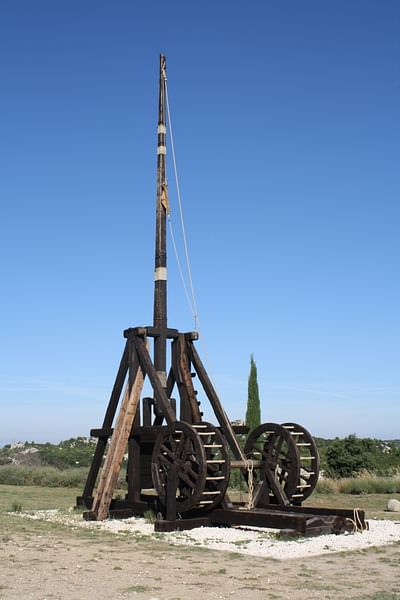
The Cannon
Gunpowder was probably invented in ancient China and presumably entered Europe via trade routes such as the Silk Road, but its potential as a means to propel a missile at great speed and distance was slow to be realised. Eventually, two brass cannons were being cast in Florence in 1326 CE and the Tower of London had its own cannons in 1338 CE. The earliest depiction of gunpowder artillery is a 1326 CE English manuscript, which shows a cannon on a wooden stand ready to fire a metal bolt. The first recorded European battle where cannons were used was the Battle of Crécy in 1346 CE, where they helped the English defeat a larger French and Genovese army.
Such early firearms, sometimes known as bombards, were first made from bronze or copper, and then, from c. 1370 CE, iron strips forged into cylinders. They fired either small balls or bolts made of wood with an iron head (garrots). Early versions were usually more lethal to the people firing them than the target; such was the lack of knowledge and design know-how of the medieval period in this area. James II of Scotland (r. 1437-1460 CE), for example, was killed by an exploding cannon in the 1460 CE siege of Roxburgh. Other limitations on their widespread use were the sheer cost of producing them, acquiring a sufficient supply of gunpowder, finding men with the skill to fire them accurately, and being able to move the cumbersome things to where they were needed in battle. Smaller cannons could be mounted on carts, but bigger ones were too big to move around easily, with wheeled and elevated carriages only in common use from the 15th century CE. One of the largest cannons produced was the Mons Meg cannon, made, again, for James II of Scotland in 1449 CE (clearly a tragic fan of the weapon), which could fire stone balls measuring 48 cm (19 inches) across and weighing 180 kilos (400 lbs) over a distance of around 250 metres (275 yards). This giant iron cannon may be seen today on permanent display at Edinburgh Castle.
Small firearms - basically handheld cannons weighing up to 15 kilos (33 lbs) - were used from the 14th century CE, probably introduced by Arab armies. More accurate handguns, which fired small balls, bolts, or lead pellets, were in use from the 15th century CE and were known as an arquebus or hackbut. New versions of metal body armour were even tested by firing such guns at close range.
A 1461 CE inventory of Caister castle in England reveals the presence of a handy collection of gunpowder weapons of various calibres. There were four breach-loading guns with eight chambers. Two of the guns could fire 15 cm (7 in) stone balls, and the other two fired 12 cm (5 in) stone balls. There was also a serpentine cannon (the smallest type), which was loaded with 25 cm (10 in) stone and a smaller one fired a 15 cm stone. There were three fowlers (a name for smaller types of cannon), which fired 30 cm stones, six smaller cannons which fired lead pellets, and seven handguns.
Unsurprisingly, walls were thickened and heightened as a response to the threat of cannons and defenders could, of course, have their own, which saw windows altered accordingly in many fortifications to give a greater arc of fire. These cannon ports had a round aperture for the cannon and a vertical slit window above for sighting, hence their common name of 'keyhole windows'. Towers and walls were sometimes lowered, too, to give a better firing platform from which to bombard the attackers if the castle had its own cannons. However, it was in attack that cannons were used with the greatest effect as warfare became more aggressive and dynamic. Cannons also became more accurate in the 15th century CE when the benefit was realised of drilling out the barrel with a steel bit to make it smoother.
Early cannons had fired stone balls which were cut for the purpose, but from the 15th century CE, cannons fired cast iron balls, and one of the most dramatic adverts for their use was the 1453 CE siege of Constantinople by Ottoman Sultan Mehmed II (r. 1444-6 & 1451-81 CE), whose army fielded 62 cannons. Cannons were also a decisive factor in the French victory of the Hundred Years War (1337-1453 CE) against England. When in the 15th century CE batteries of huge cannons were being more widely used, which fired balls weighing over 100 kilos (220 lbs), the days of static siege warfare effectively came to an end as no fortifications could resist a barrage of such cannon fire for very long. In addition, when firearms overcame the early problems of inaccuracy and slow loading time, their obvious advantages in penetration and the lack of skill needed to fire them compared to such traditional weapons as the longbow meant that the gun changed warfare completely just as the medieval period was coming to a close.
